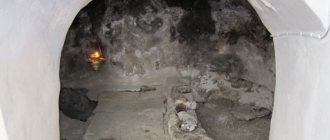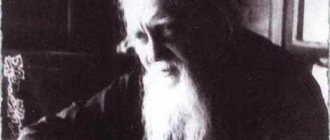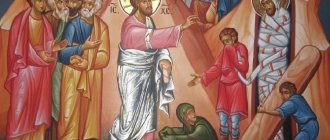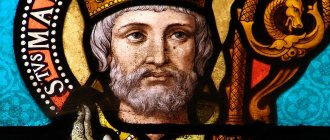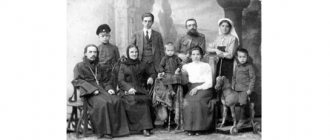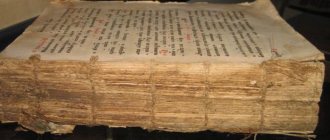Saint Leonty, Bishop of Rostov
Saint Leonty, Bishop of Rostov, is one of the outstanding archpastors of the 11th century of the Russian land. According to Saint Simon, Bishop of Vladimir, which can be considered quite reliable, Saint Leonty was a tonsure of the Pechersk Monastery and was Russian by origin, not Greek, although he was born in Constantinople. By the providence of God, the future enlightener and apostle of the Rostov land passed obedience under the spiritual guidance of the founders of Russian monasticism, the Venerables Anthony († 1073; commemorated September 28/October 11 and July 10/23) and Theodosius († 1074; May 3/16, 14/27 and August 28/September 10) Pechersky. He was the first bishop to emerge from the monastery in the Kyiv caves, which educated numerous saints of the Russian land. “From that Pechersk Monastery of the Most Pure Mother of God,” writes Saint Simon, “many bishops were installed and, like a bright light, illuminated the entire Russian land with Holy Baptism; the first Leonty, Bishop of Rostov, holy martyr, whom God glorified with incorruption and became the first throne, whose unfaithfulness, tormented him a lot, killed him.”
Hieromartyr Leonty began his Equal-to-the-Apostles feat after he was elevated to the rank of bishop in the forties of the 11th century and appointed to the Rostov See.
In the Rostov land, inhabited at that time by Chud tribes, the saint met fierce resistance from the pagans, who expelled his two predecessors - bishops Theodore and Hilarion. The inveterate pagans did not even want to listen to him, but Saint Leontius, like a good shepherd, decided to lay down his soul for the salvation of the flock entrusted to him by God. Despite the constant danger, Saint Leonty zealously converted the local population to Christ, firmly following the apostolic commandments. Once he was beaten by pagans and expelled from the city, but did not leave the spiritual flock entrusted to him and settled not far from Rostov, near the Brutovshchina stream, where he built a small temple in honor of the Archangel Michael. The saint endured everything and zealously continued to preach the faith, confirming its truth with miracles. Children of local residents began to come to the saint, attracted by his spiritual kindness. The saint of God taught the children the principles of the Christian faith and then baptized them. Soon the adult population reached out to the gracious archpastor and also received Holy Baptism.
The hardened pagans became agitated, their hostility towards the enlightener grew, and finally, having gathered in a huge crowd, some with clubs, others with weapons in their hands, they went to the cathedral to kill or drive out Leontius. The cathedral clergy was frightened, but the saint was calm and strengthened those with him, saying: “Do not be afraid, children, without God’s will they will not do anything to us.” Holy Bishop Leonty dressed himself in holy robes and ordered the clergy of the temple to do the same. With a cross in his hands, he went out to meet the pagans. The apostolic firmness and calmness of Saint Leontius before the threat of death stopped the excited crowd, and his word, filled with grace, had an even greater impact on people, and many of them received Holy Baptism. From that moment on, Saint Leonty began to more successfully affirm the light of Christ's faith in the land of Rostov. “Then the idolatrous darkness began to leave us and the light of good faith began to shine,” says the ancient Rostov word in memory of Leonty. Preaching about Christ the Savior, he walked around the surrounding land, and his path was marked by the establishment of Orthodoxy in places of former idolatry.
The apostolic feat of Saint Leontius was crowned with martyrdom. In 1073, he was killed by hardened pagans on the orders of the Magi.
The body of the saint was buried in Rostov the Great in the Church of the Most Holy Theotokos. During a fire in 1160, this temple burned down, and by order of the blessed prince Andrei Bogolyubsky († 1174; commemorated July 4/17), a stone cathedral was founded on the site of the previous one in 1162. “On May 23, 1164, while digging ditches, they found a coffin,” the chronicler Nikon says in his life, “covered with two boards, they opened it in bewilderment and saw the face (of Leonty), glowing with glory: the vestments on him were as if they had been worn yesterday, how many years had passed, and his sacred body did not change.” In his hands lay a scroll with the names of the priests and deacons he had enlightened. The found relics were transferred to a stone coffin and placed in the church in the name of the holy Apostle and Evangelist John the Theologian in the bishop's courtyard.
In 1170, when the construction of the stone church in honor of the Most Holy Theotokos was completed, the tomb of St. Leontius was transferred to this temple and placed in a niche in the southern wall.
Saint Leonty, almost unknown during his lifetime, after his death became so famous and popular that the Rostov department was called “the department of Leonty the Wonderworker”; When electing new bishops for Rostov, the chroniclers note that “appointed through the prayers of St. the wonderworker Leontius” such-and-such a bishop. Rostovites resorted to St. with prayer. Leonty. Numerous blessed miracles were performed at the tomb of the enlightener of the Rostov land. Testimonies about the holiness of Bishop Leonty’s life, miraculous healings and signs through his prayers were collected by Bishop John of Rostov (1190–1214). With the blessing of Metropolitan Theodore, it was established to celebrate the memory of St. Leonty on May 23/June 5, the day of the discovery of the relics. Bishop John also wrote a canon for Saint Leontius. Until 1609, the relics of St. Leontius were openly located in the Assumption Cathedral, but after the Poles stole the saint’s tomb in troubled times, they were placed under cover in the same church near the southern wall of the chapel in the name of St. Leontius, where they remain to this day.
Saint Leonty is one of the greatest saints of the Rostov land. He is great in the actions of earthly life, as the Equal-to-the-Apostles enlightener of the Rostov region; He is great in heaven, as a strong prayer book for the Russian land. Saint Leonty stands among the first successors to the apostolic ministry of the Russian Church, following the holy Equal-to-the-Apostles Princess Olga († 969; commemorated July 11/24) and the Great Equal-to-the-Apostles Prince Vladimir († 1015; commemorated July 15/28).
Essays
The teachings of Saint Leontius that have come down to us in two manuscripts [6] speak about the importance of the priesthood, repentance, penance, baptism, the resurrection of the dead and monotheism.
- “Teaching to the priests about everything and punishment of Bishop Leonty of Rostov to the priests about everything, how a child should be taught spiritually and the rule of the holy fathers,” Monuments of Old Russian canon law
[Ed. A. S. Pavlova] St. Petersburg, 1908, part 1 (Monuments of the XI-XV centuries). - Ed. also: “Moscow Eparch. Vedomosti,” 1878, No. 24, 25; “Yaroslavl Eparch. Vedomosti" 1878, No. 12; “Russian Historical Library, published by the Archaeographic Commission: in 39 volumes,” St. Petersburg-Leningrad, 1872-1927; 1908, vol. 6, stb. 111-116.
Literature[ | ]
- Iconography of Rostov saints. Exhibition catalog / comp. A. G. Melnik. - Rostov, 1998. - 80 p.
- Melnik A.G.
Icon of Leonty of Rostov from the Resurrection Goritsky Monastery // Kirillov: Local History Almanac. - Vologda: Legia, 2001. - Vol. 4. - pp. 212-218. — ISBN 5-89791-022-7. - Melnik A.G.
Formation of the cult of St. Leonty of Rostov in the pre-Mongol era // Messages of the Rostov Museum. Sat. Art. in honor of the corresponding member. RAS S. M. Kashtanova. - Rostov, 2003. - Issue. 13. - pp. 144-152. - Melnik A. G.
Saint Leonty of Rostov: equal to the apostles or martyr? // Message Rostov Museum. - Rostov, 2003. - Issue. 14. - pp. 86-90. - Melnik A.G.
Veneration of Saint Leonty of Rostov in the pre-Mongol era // Uvarov Readings - V. - Murom, 2003. - P. 100-103. — ISBN 5-94951-005-4. Archived from the original on December 20, 2021. - Melnik A. G.
Hagiographic icon of Leonty of Rostov from the collection of the Uglich Museum // Problems of source study. - M.: Nauka, 2006. - Issue. 1(12). - pp. 392-399. — ISBN 5-02-034003-0. - Melnik A.G.
Social functions of Rostov saints in the XII-XVII centuries // Ist. notes. - M.: Nauka, 2008. - Issue. 11(129). - P. 75-93. — ISBN 978-5-02-036736-4. - Melnik A.G.
On the reflection of the life of Leonty of Rostov in the icon of this saint from the collection of the Yaroslavl Art Museum // Book culture of the Yaroslavl region: Scientific materials. conf. (October 8-9, 2008). - Yaroslavl, 2009. - pp. 99-105. — ISBN 978-5-91637-004-1. - Melnik A.G.
Little-known hagiographic icon of Leonty of Rostov in the 16th century // Makarievsky readings. Primordial Rus' - Baptized Rus'. - Mozhaisk, 2012. - Issue. 19. - pp. 305-314. — ISBN 978-5-9902186-5-9. - Melnik A. G.
History of the spread of the cult of St. Leonty of Rostov in Rus' in the XV-XVI centuries // History and culture of the Rostov land. 2015. - Rostov, 2021. - pp. 18-33. — ISBN 978-5-9908342-4-8. - Melnik A. G.
Hagiographic icons of Leonty of Rostov XVI-XVIII centuries. // Book culture of the Yaroslavl region - 2021. - Yaroslavl, 2021. - pp. 18-36. — ISBN 978-5-906275-41-7. - Melnik A. G.
Life of Leonty of Rostov in miniatures of the Front Chronicle // History and culture of the Rostov land. 2021. - Rostov, 2021. - pp. 125-135. — ISBN 978-5-9908342-9-3. - Melnik A.G.
Icons of Leonty and Isaiah of Rostov from the iconostasis of the Church of All Saints of the Rostov Bishop's House, created by order of Bishop Dosifei (1711-1718) // History and culture of the Rostov land. 2021. - Rostov, 2021. - pp. 249-263. — ISBN 978-5-9908342-0-0. - Melnik A.G.
The Life of Leonty of Rostov as a source on the history of the veneration of this saint at the end of the 14th–15th centuries // Book culture of the Yaroslavl region - 2021. - Yaroslavl, 2021. - pp. 5-15. — ISBN 978-5-9500778-5-2. - Nikolsky A.
Leonty (Bishop of Rostov) // Russian Biographical Dictionary: in 25 volumes. - SPb.-M., 1896-1918. - Trubacheva M. S.
Life image of Leonty of Rostov from the collection of the Murom Museum and its literary source // Uvarov Readings - III. Russian Orthodox monastery as a cultural phenomenon: history and modernity: Scientific materials. conf., dedicated 900th anniversary of the Murom Spaso-Preobrazhensky Monastery. - Murom, 2001. - pp. 82-86. - Filippovsky G. Yu.
Life of Leonty of Rostov // Dictionary of scribes and bookishness of Ancient Russia. XI - first half of the XIV century. - L., 1987. - P. 159-161. - Filippovsky G. Yu.
On the origin of the early short edition of the Life of St. Leonty of Rostov // Ancient Rus'. Questions of medieval studies. - 2007. - No. 3 (29). — P. 115-116.
Literature
- Klyuchevsky, V. O., Old Russian lives of saints, as a historical source
, M., 1871, 3-22. - Macarius (Bulgakov), Metropolitan, History of the Russian Church: in 12 volumes
, St. Petersburg, 1864-1886, vol. 2, 23-24, 315-317. - Titov, A. A., Life of St. Leontius, Bishop of Rostov
, M., 1893. - Shemyakin, V.I., Moscow, its shrines and monuments
, M., 1896, 141. - Sreznevsky, I. I., Ancient monuments of Russian writing and language (X-XIV centuries): General time-by-time review and additions with paleographic instructions, extracts and indexes
, 2nd ed., St. Petersburg, 1882, 120, 142. - Nikolsky, N.K., Materials for a time-based list of Russian writers and their works (X-XI centuries)
, St. Petersburg, 1906, 210-211. - Historical dictionary about saints glorified in the Russian Church, and about some ascetics of piety, locally revered
[Comp. D. A. Eristov, M. L. Yakovlev_], 1st ed., St. Petersburg, 1836, 167-168. - Barsukov, N.P., Sources of Russian hagiography
, St. Petersburg, 1882, 323-329. - Golubinsky, E. E., History of the Russian Church: in 2 volumes
, M., 1900-1911, volume 1, first half, 201, 202, 757-758; second half, 433. - Kamanin, I.M., Zverinetsky caves in Kiev, their antiquity and holiness
, Kiev, 1914, 40-42, 133, 137, 139. - Arkhangelsky, N.V., Newly discovered Zverinetsky caves in Kiev
, Kiev, 1915, 15. - Demetrius (Sambikin), archbishop, Months of the saints, the entire Russian Church or locally revered: in 14 issue.
, Kamenets-Podolsk, Tver, 1892-1902, issue. 9, part 2, May, 123-129. - Edlinsky, M.E., priest, Ascetics and sufferers for the Orthodox faith and the Holy Russian land from the beginning of Christianity in Russia to later times
, 1st ed., St. Petersburg, 1895, 143-145; 4th ed., St. Petersburg, 1901-1903, vol. 1, 148-151. - Tolstoy, M.V., Ancient shrines of Rostov the Great
, 2nd ed., M., 1860, 25, 33, 34, 35, approx. 13. - Tolstoy, M.V., Stories from the history of the Russian Church
, M., 1873, 47-49. - Archimandrite Pimen, abbot of the Nikolo-Ugreshsky Monastery (1810-1880): Biographical sketch
, M., 1881, 335 (approx.). - Bulgakov, S. V., Handbook for clergy
, Kiev, 1913, 1417. - Stroev, P. M., Lists of hierarchs and abbots of monasteries of the Russian Church
, St. Petersburg, 1877, 329. - Chronicle of church and civil events, explaining church events, from the Nativity of Christ to 1898, Bishop Arseny
, St. Petersburg, 1899, 391. - Leonid (Kavelin), archim., Holy Russia
, St. Petersburg, 1891, No. 615. - Yaroslavl Diocesan Gazette
, 1892, № 33; 1888, № 41, 641-656; № 42, 657-660; № 43, 673-686; № 45, 715; 1889, № 29. - Soulful reading
, M., 1885, May, 44-66. - Orthodox interlocutor
, Kazan, 1858, March, 420-431; February, 297, 318; 1898, October, 484; 1901, May, 302-303. - Historical Bulletin
, St. Petersburg, 1886, vol. 23, 76. - News from the Kazan diocese
, 1885, № 7, 144. - Russian pilgrim
, 1911, № 22, 347. - Leonid (Polyakov), archbishop, “Saint Leonty, Bishop of Rostov,” Journal of the Moscow Patriarchate
, M., 1964, No. 6, 66-68. - Complete Orthodox Theological Encyclopedic Dictionary: in 2 volumes
[Ed. P. P. Soikina], St. Petersburg, b. g., t. 2, 1519. - Russian biographical dictionary: in 25 volumes
, St. Petersburg; M., 1896-1913, vol. 10, 221-223. - N. D[urnovo]., Nine hundredth anniversary of the Russian hierarchy 988-1888.
Dioceses and bishops , M., 1888, 22. - Minea May
, M., 1987, part 3, p. 20-21: - Tvorogov, O. V., “Leonty,” Dictionary of scribes and bookishness of Ancient Russia
, L., 1987, no. 1, 229-230. - Macarius (Bulgakov), Metropolitan, History of the Russian Church: in 9 volumes
, M., 1994-1997, vol. 2, p. 137-138. - Andronik (Trubachev), abbot, Holy Russia.
Chronological list of canonized saints, revered devotees of piety and martyrs of the Russian Orthodox Church (9th - mid-13th centuries) addition to the book of Metropolitan Macarius (Bulgakov) History of the Russian Church , M., 1995, vol. 2, 650. - Melnik A.G., “Saint Leonty of Rostov: equal to the apostles or martyr?” // Messages of the Rostov Museum / - Rostov, 2003. - Issue. 14. - p. 86-90:
Kamanin, I.M., Zverinetsky caves in Kiev (their antiquity and holiness)
, Kiev, Kiev-Pechersk Lavra, 1914, 39-42.
Notes[ | ]
- ↑ 1 2 3 4 5 6 7 8 9 Nikolsky A.
Leonty (Bishop of Rostov) // Russian Biographical Dictionary: in 25 volumes. - SPb.-M., 1896-1918. - Golovshchikov K. D.
Leonty, Bishop of Rostov // Encyclopedic Dictionary of Brockhaus and Efron: in 86 volumes (82 volumes and 4 additional). - St. Petersburg, 1890-1907. - The history of the canonization of saints in the Russian Church.
- Homily 14. Message from the humble Bishop Simon of Vladimir and Suzdal to Polycarp, Monk of Pechersk.
- A shrine was installed on the relics of St. Leontius (unspecified)
. Yaroslavl Metropolis (December 23, 2019). Date accessed: December 23, 2021.
